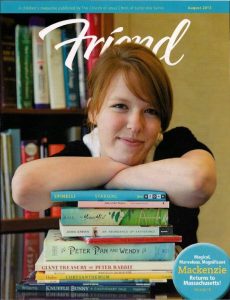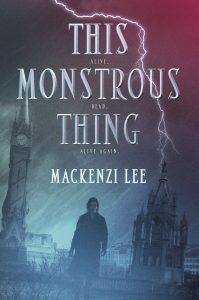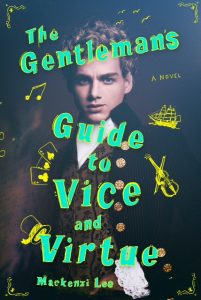Below is a blog post by the author Mackenzi Lee, from August, 2013. I thought it was delightful, and asked Mackenzi to allow us to reprint it here. Lee has since had two YA novels published to great acclaim, including The Gentleman’s Guide to Vice and Virtue, which has received starred reviews from Publishers Weekly, Kirkus Reviews, School Library Journal, and Booklist, and which debuted at #8 on the New York Times Young Adult Hardcover list last week. I will include more about Lee and her books at the end of this post. For now, enjoy her 2013 post, which she wrote while she was working as an intern at the Friend magazine.
When I was a kid, I wanted to be a detective.
I think every kid goes through this phase at one point, and I remember mine very distinctly. I read detective books. Played detective games1. Had a detective club2.
But I was never good at solving mysteries. Not even the really obvious ones that all my friends claimed they had figured out from page five. I combated this by mostly reading mystery books that were billed as unsolvable, like Westing Game and And Then There Were None, so I didn’t feel so stupid when I couldn’t figure them out.
I’ve always loved mysteries, but real life mysteries are not like books. The clues never appear as conveniently or fit together as neatly as they do in books. And mysteries, contrary to what Nancy Drew led me to believe, do not happen every day.
But this week, I got to solve a real-life mystery. And not just any mystery—a kid lit mystery!
The story of my kid lit mystery begins yesterday morning. I was very grumpy yesterday morning. The hard drive on my work computer died, and thus I couldn’t do any work for a while. The only non-computer assignment I had was one my editor had given me a few days ago: a man had called and asked us to find a song he thinks was maybe in the Friend sometime between now and forty-five years ago, and he didn’t know the title, just the first line3. Seriously. So my job was to go through old copies of the Friend from the sixties and find the song.
I was not looking forward to this job, so I grumpily pulled up a stool in our archives and started grumpily going through copy after copy after copy of vintage Friends.
And then I found this:
The cover of the November 1969 issue.
And I immediately thought to myself, “That looks a lot like Maurice Sendak art.” And I opened the cover and found this. 
And then I freaked out. Maurice Sendak, my favorite artist ever, one of my favorite kid lit writers, had done a cover for our little LDS children’s magazine! I immediately ran to tell my editor, who shares my passion for children’s books. We had a moment of surprise and celebration, and then she said, “What else do you know about it?”
Nothing, I said. I didn’t know anything. I didn’t know if the painting was commissioned by the Friend. I didn’t know where it was now. I didn’t know how a Caldecott-winning artist and outspoken atheist had come to do art for a Mormon magazine.
So I decided to solve the mystery of the lost Maurice Sendak painting4.
I started with the Google, and found exactly one other place that the painting appeared: there was a grainy iPhone photo of it accompanying a Sendak obituary. I tweeted the author of the article about it, and he directed me to the Rosenbach Museum, where all Sendak’s art and papers were collected after his death.
The curator at the Rosenbach was very helpful, and emailed me back in minutes. He said:
“I know only a little about that piece, but basically I think you’re correct that Children’s Friend (as it was called at the time) commissioned the art from Sendak. His usual process was to do an unknown number of doodles or sketches, then compose them in pencil on tracing paper, usually using a light table. I believe we have this preliminary drawing at the museum. The “final” artwork…is privately owned in the hands of Sendak collector Justin Schiller.”
To Justin Schiller’s website!
He replied this morning:
“I purchased the original watercolor for “The Children’s Friend” magazine (as it was then called) directly from the artist in early 1970. All I can recall was that Maurice told me at the time he had a friend associated with the magazine who asked him to illustrate a cover design. I do not recall the name of the friend ever being mentioned.”
Dead end, it would seem! But I had to know who on staff of the Friend had known Maurice Sendak! What ties did he have to my weird little Church. So I took a different approach.
One of the many strange things about the LDS Church is that they really keep tabs on their members. Not like CCTV or hidden camera tabs or anything creepy like that, but they know where you are and what you are doing and how to contact you at all times through pretty comprehensive membership records5. The benefit of this is that I was able to take the staff names from the table of contents in the November 1969 Friend and send them to our secretary, who was able to get me their records. Turns out they were almost all dead. But I had their posterity’s phone numbers and addresses. So I swallowed my crippling fear of talking on the phone to strangers6 and began to call.
I called probably ten people. No one knew anything about their parent’s work with the Friend, and less about a connection with Sendak. I was starting to despair. Perhaps I just would never know the origin story.
Then I got a phone call on my lunch break today from a man in Virginia. “You left a message for me,” he said. “About the Friend.”
I told him my problem. “I’m trying to find out who on the Friend staff would have known Maurice Sendak,” I explained. “Do you have any idea?”
And he said simply, “It was my mom.”
So here is the story. It’s maybe not novel worthy, or really that dramatic at all, but I solved it. I followed the trail of clues and I found my answers7.
In the 1960s, Gladys Daines was the managing editor of the Children’s Friend. In 1962, she had bought herself a copy of Where the Wild Things Are and fallen in love with its boxy, whimsical art. So, bold as brass, she called up Maurice Sendak and asked to visit him. She flew to his house in New York and they had a good chat and hit it off. She then asked if he’d be willing to do some art for the Children’s Friend. Apparently, he was more than happy to do it. They collaborated on the initial ideas, he sent her sketches, she approved them, and then in November 1969, the cover was published. Though at the time the Friend kept most of the art they commissioned, Sendak kept his painting because he was such a prominent illustrator. He sold it a few years later to collector Justin Schiller, who owns it today. The sketches Sendak sent to Gladys are in the Rosenbach.
And this is now featured prominently on my desk.
My first real mystery—solved. Ten year old me would be so proud, and current me is ecstatic.
- Which did not work, because I was both creator of the mystery and solver of it.
- Which did not work because there were no mysteries in my neighborhood, though books led me to believe that if I had the intention of being a detective, mysterious things would start happening. Children’s lit lied to me.
- This is not the mystery I solved. Just FYI.
- Not technically lost. I sort of hoped it would be, and I would have to crawl through the bowels of the Church Office Building, fight some corrupt art dealer, and then eventually would have a write up in the paper after the painting was recovered with my photo under the word “CHILDREN’S LIT HERO.” None of those things happened.
- Don’t think too hard about this or it all starts to feel vaguely 1984.
- FOR SENDAK! *raises sword and charges into battle*
- You really do get a rush from detecting. This must be how Sherlock Holmes feels all the time.
 Mackenzi Lee holds a BA in history and an MFA from Simmons College in writing for children and young adults, and her short fiction and nonfiction has appeared in Atlas Obscura, Crixeo, The Friend, and The Newport Review, among others. Her debut novel, This Monstrous Thing, won the PEN-New England Susan P. Bloom Children’s Book Discovery Award, and was a finalist for two Whitney Awards. Her second book, The Gentleman’s Guide to Vice and Virtue, a queer spin on the classic adventure novel, was a New York Times bestseller (what is life?), and ABA bestseller, earned five starred reviews, a #1 Indie Next Pick, and was shortlisted for the New England Book Award.
Mackenzi Lee holds a BA in history and an MFA from Simmons College in writing for children and young adults, and her short fiction and nonfiction has appeared in Atlas Obscura, Crixeo, The Friend, and The Newport Review, among others. Her debut novel, This Monstrous Thing, won the PEN-New England Susan P. Bloom Children’s Book Discovery Award, and was a finalist for two Whitney Awards. Her second book, The Gentleman’s Guide to Vice and Virtue, a queer spin on the classic adventure novel, was a New York Times bestseller (what is life?), and ABA bestseller, earned five starred reviews, a #1 Indie Next Pick, and was shortlisted for the New England Book Award.
 She loves Diet Coke, sweater weather, and Star Wars. On a perfect day, she can be found enjoying all three. She currently calls Boston home, where she works as an independent bookstore manager.
She loves Diet Coke, sweater weather, and Star Wars. On a perfect day, she can be found enjoying all three. She currently calls Boston home, where she works as an independent bookstore manager.
For more about her time at the Friend, read where she compares being an intern at the Friend with another intern gig at NPR’s Wait Wait . . . Don’t Tell Me, and where she looks back at her time there. She had several stories published in the magazine, as Mackenzie Van Engelenhoven. She is an outspoken supporter of LGBT rights and including LGBT stories in YA literature. This recent Publishers Weekly interview is a good place to get caught up with her.





What?! This story made my day! Great sleuthing and what a delightful Mormon treasure!
Loved this article!! Who knew?
This is the best story of the week. SO COOL. And thank you doe posting the front AND back!
In Nov 1969 I was 11 and in 6th grade, so I may have seen this cover when it came out. It looks vaguely familiar, I had read Where the Wild Things Are a bunch of times, but I was in high school before I realized Sendak had done a bunch of other things. I saw an article about him in Rolling Stone that said “for his first 20 books” Sendak had used a particular style of line drawing. “20 books? Really.” I’m not sure I was paying attention to The Children’s Friend by then. I was pursuing my goal of reading all 80 of Erle Stanley Gardner’s Perry Mason mysteries. (I tried one Donald Lam-Bertha Cool mystery, but had no grounding in the hard-boiled detective tradition. Never read any of the DA novels.)
At the beginning of the next school year my father was a Fulbright Professor at the University of Oulu, Finland, and Oulun Kirjasto didn’t have but one Perry Mason novel. That may have been when I graduated to Agatha Christie, or after we got back to Provo. Later I started reading Maurice Sendak. He came to speak at the U of (there is no R in ) Washington in 1985, I think. He mentioned that he had been approached about doing a Christmas book. “I’m a Jew. What do I know about nativity stories?” “Maurice, they were all Jews.”
I followed the links in this story and am glad the people at The Friend know what “Wait, Wait, Don’t Tell Me” is. It gives me hope for the diversity of our culture. (And when did you get this stereotype of them as an ultra conservative bunch who would eschew comedy news quizzes?) The PW interview was also quite interesting. I’ll have to read some of Van Engelenhoven’s stories in The Friend.